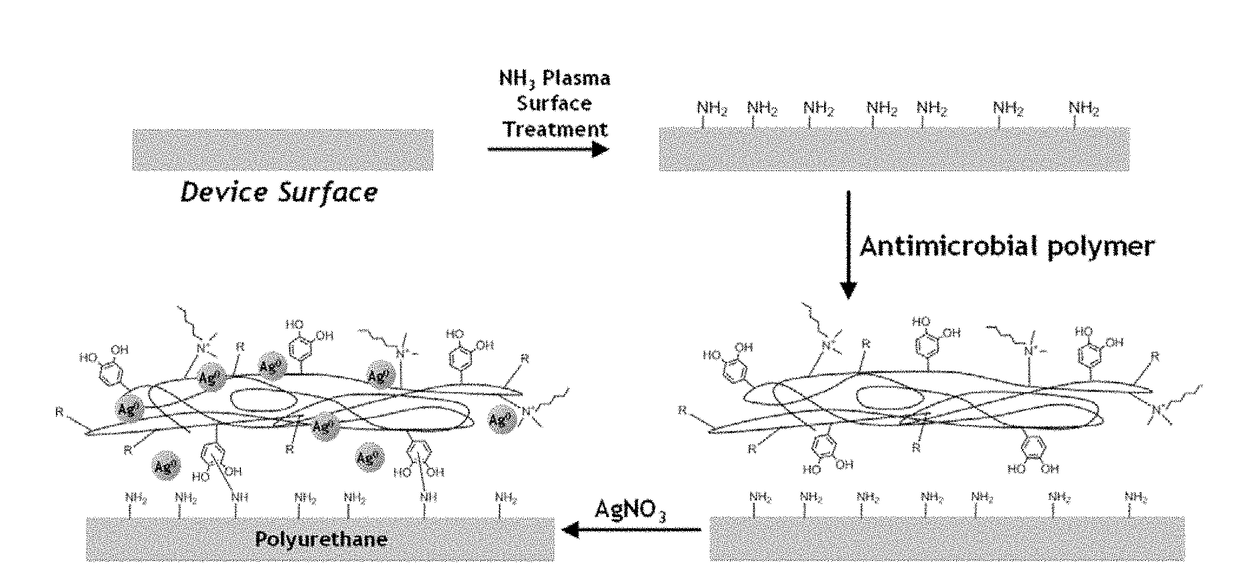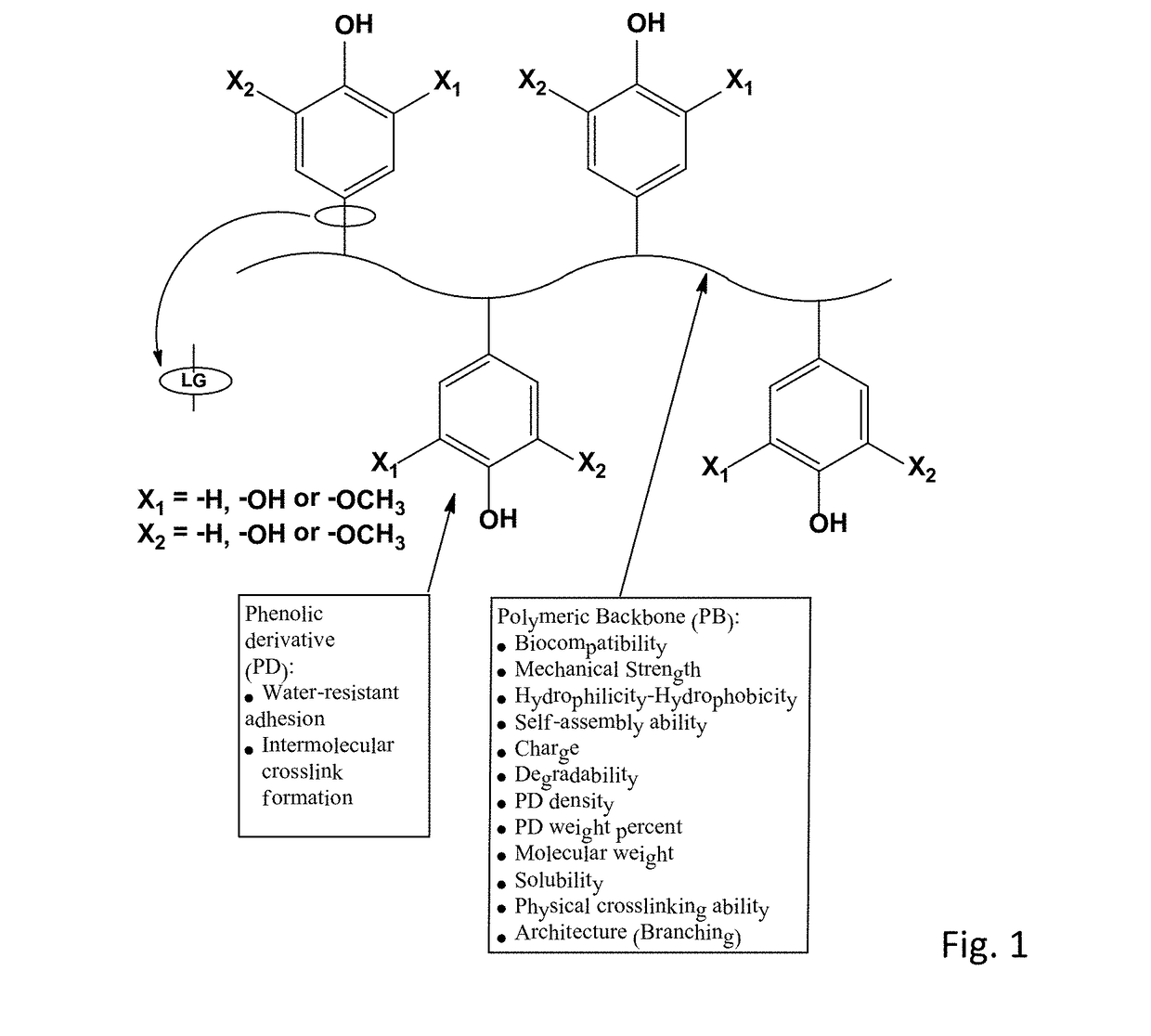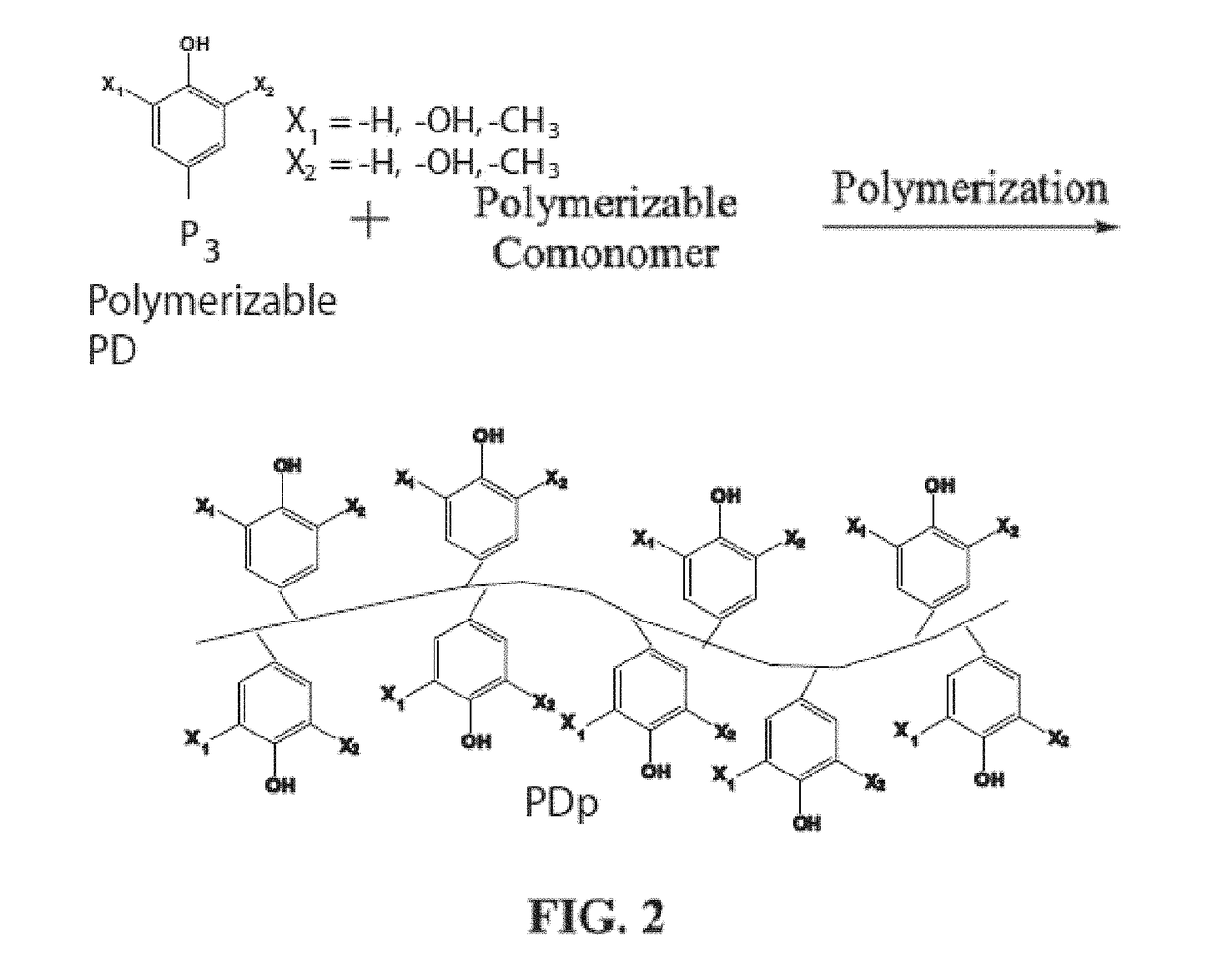Bioadhesive compounds and methods of synthesis and use
- Summary
- Abstract
- Description
- Claims
- Application Information
AI Technical Summary
Benefits of technology
Problems solved by technology
Method used
Image
Examples
example 1
General Route for the Synthesis of Surphys S-093-S-107
[0212]Monomer compositions in mole percent monomers a, b, and c of S-093-S-107 antimicrobial antifouling polymers of the present invention are provided in Table 1 (FIG. 8). For example, for synthesis of S-095 DMA (0.665 g, 3.01 mmol), DMAEMAC12 (4.853 g, 11.94 mmol), MEA (0.659 g, 5.06 mmol), and AIBN (50 mg / (g DMA)) were measured and delivered to an appropriately sized round bottom flask. N,N-Dimethylformamide (DMF) (15 mL / (g DMA)) was added to the reaction vessel. The flask was immediately capped, and an inert gas sparge was applied for a minimum of 20 minutes. The sparge was replaced with an inert gas purge. The round bottom flask was placed in an oil bath preheated to approximately 60° C. It was confirmed that the reaction flask had a pathway to vent. The reaction was allowed to progress overnight. The polymer was precipitated by addition of the reaction solution into diethyl ether (600 mL / (g DMA)). The mixture was placed at ...
example 2
Synthesis of Dopamine Methacrylate (DMA)
[0214]20 g (238.1 mmol) of sodium bicarbonate and 50.1 g (131.1 mmol) of sodium tetraborate was added to a 1000 mL round bottom flask. 500 mL of nanopure water was added to the round bottom flask which was purged with nitrogen while heating at 50° C. Heating and stirring allowed for the complete dissolution of sodium bicarbonate and sodium tetraborate. The mixture was removed from the heat source and 25 g (131.8 mmol) of dopamine hydrochloride was added and stirred until dissolved. 100 mL of 1N sodium hydroxide was added to the reaction mixture. 23.5 mL (221.4 mmol) of methacrylic anhydride was dissolved in 125 mL of anhydrous THF and added dropwise to the solution over a period of 15 minutes. The reaction was stirred for 21 hours under argon. Once complete, 105 mL of THF was rotary evaporated off. The remaining solution was poured into 1 L of nanopure water. 50 mL of concentrated HCl was added to adjust the pH to ˜0.5. Four extractions with a...
example 3
Synthesis of DMAEMAC12
[0216]75 mL (309.8 mmol) of 1-Bromododecane was added to a 1 L round bottom flask. 210 mL of acetonitrile and 110 mL of chloroform was added to the flask which was purged with argon for 10 minutes. 46 mL (272.4 mmol) of 2-(dimethylamino)ethyl methacrylate was added to the reaction. The reaction was placed at 40-45° C. with argon purging for 20 hours. ˜½ of the solvent was rotary evaporated off. The solution was poured into 1.7 L of diethyl ether and placed at −15° C. for 90 minutes. The precipitate was suction filtered off, washed with MTBE and placed under vacuum overnight. The precipitate was dissolved in 200 mL of chloroform and poured into 1.7 L of diethyl ether. The solution was placed at −15° C. for 3 hours. The precipitate was suction filtered and placed under vacuum until dry. 72.92 g of pure material was obtained.
1H NMR (400 MHz, DMSO / TMS): δ6.06; (s, 1H, CH2═C(CH3)—COO—), 5.75; (s, 1H, CH2═C(CH3)—COO—), 4.50; (t, 2H, —COO—CH2—CH2—N+(CH3)2—CH2—), 3.69...
PUM
| Property | Measurement | Unit |
|---|---|---|
| Fouling properties | aaaaa | aaaaa |
| Antimicrobial properties | aaaaa | aaaaa |
| Physical properties | aaaaa | aaaaa |
Abstract
Description
Claims
Application Information
 Login to View More
Login to View More - R&D
- Intellectual Property
- Life Sciences
- Materials
- Tech Scout
- Unparalleled Data Quality
- Higher Quality Content
- 60% Fewer Hallucinations
Browse by: Latest US Patents, China's latest patents, Technical Efficacy Thesaurus, Application Domain, Technology Topic, Popular Technical Reports.
© 2025 PatSnap. All rights reserved.Legal|Privacy policy|Modern Slavery Act Transparency Statement|Sitemap|About US| Contact US: help@patsnap.com



